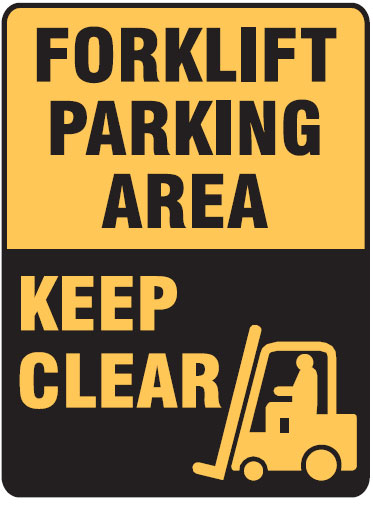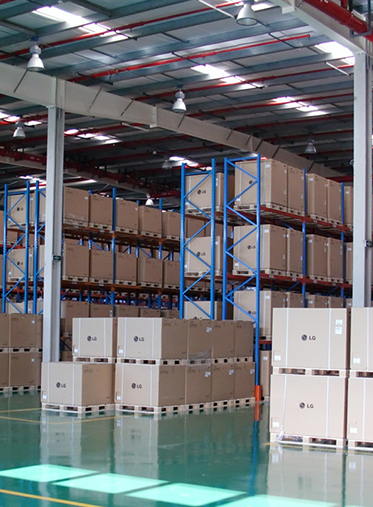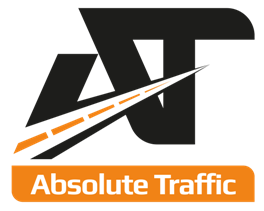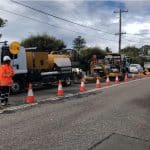Warehouse traffic management has become more important than ever. Indeed, while many industries have suffered under the pandemic, the demand to develop warehouses and distribution centers has skyrocketed. In fact, customers increasingly purchase goods online and expect delivery to their doorsteps. And, this has only been accentuated by COVID-19 lockdowns. Also, logistics experts predict this trend will continue even as the economy re-opens.
As a result, warehouse traffic management is important to ensure productivity. But, also to ensure that the workplace is without risks to health and safety. In particular, because vehicles including powered mobile plants move in and around a workplace, reverse, load and unload. And, they frequently cause deaths and injuries to workers and members of the public.
So, with this in mind, warehouse traffic management needs to consider pedestrian safety. And, they need to have measures for pedestrians working with vehicles, for the layout of the work area. In brief, they need to develop and implement a warehouse traffic management plan.
In this article, we’re sharing Safe Work Australia’s recommendations on warehouse traffic management. Below, learn how to manage risks coming from traffic movements in warehouses, including cars, delivery trucks, powered mobile plants, and pedestrians.
Ensure Pedestrian Safety in the Warehouse
First, a person conducting a business or undertaking must ensure pedestrian safety within the warehousing site. To do so, they can:
- For instance, use overhead walkways to separate vehicles and pedestrians: They are a great way to maximise the space available to you by providing an accessible route for both workers and materials to get around.
Also, if the design and layout of the warehouse allows it, consider building overhead walkways so that the workers do not ever get in the way of the moving vehicles. However, if this is not possible due to the design or space constraints, consider the following:
- Install physical separation structures (barriers): At Absolute Traffic Management, we have a large range of railed barriers to delineate areas of pedestrian movement or safe work zones. For instance, water barriers are ideal for pedestrian and low speed zones
- Use separate pedestrian doors at vehicle entries and exits
- And, use safety railings or bollards to create physical barriers for traffic and protect site perimeters without impeding pedestrian flow.
- Use safety measures like walkways and safety zones
- And, pedestrians that need to work with the vehicles, helping with the loading and unloading of goods should wear high-visibility clothing so that their presence is easily noticed.
- Use engineering controls like interlocked gate and zoning systems
- Separate designated areas for pedestrians and for vehicles
- In addition, implement signage that specifies the procedures for both the pedestrian and moving vehicles. This signage must clearly indicate who has the right of the way. Site plans that specify the flow of the vehicular traffic also play an important role in ensuring the safety of the pedestrians
- Finally, display site maps of the workplace to indicate traffic flow
Take Measures for Pedestrians Working with Vehicles
Next, where pedestrians are working with or near vehicles and powered mobile plant, the manager should:
Take Measures For The Use of Loadshifting Equipment
Here, use low speed, stable, light-weight loadshifting equipment like powered pallet trucks or walkie stackers.
Because forklifts can be one of the most high risk pieces of equipment in the workplace, workers should be aware of:
Consequently, to minimise the risks, separate pedestrians and forklifts. Nevertheless, if this is not possible, you may:
Many of the accidents in warehouses involve the workers involved with loading and unloading of goods on to the trucks. Consequently, it is imperative for organisations to create safe loading and unloading exclusion zones so that the risk to drivers and workers can be minimised, if not completely eliminated.
Absolute Traffic Management can help you with traffic plans and traffic control equipment hire. And, we have a large range of railed barriers to delineate areas of pedestrian movement or safe work zones.

Share The Layout of the Warehouse Work Area
In addition, consider physical barriers to separate pedestrians and vehicles. For example, for a safer layout, you can:
Driver-designated safety zones with signage have an important role in the execution of traffic management plans in warehouses.
Driver Designated Safety Zones
They help designating specific travel paths for vehicles and pedestrians, and minimise crossflows. Also, these zones help specify vehicle parking areas, so the workers avoid them if they are not responsible for the loading and unloading of the vehicle. The signs warn that an area is for load-shifting equipment parking, is a vehicle-only or a pedestrian-only zone, has a speed limit, etc. These zones give directions and visual warnings.
Use wireless radios and hand signals to acknowledge the person received and understood the message. And, include car parking areas, keep clear zones, speed limits and speed inhibiting devices like speed humps.

Have Signs, Warning Devices and Visibility
Then, display clear warning signs in areas which are easy to find and are well lit. Specifically, to remind people of the traffic management hazards and other requirements.
Thus, examples of signs which can be used include:
Contact the team at Absolute Traffic Management for your device and sign hire inquiries.
Develop and Implement a Warehouse Traffic Management Plan
With this in mind, a traffic management plan is the solution for safe and productive warehouses. In short, it documents and helps explain how risks will be managed at the warehouse. So, here are the recommendations published in the Health and Safety Handbook website.
How to write a traffic management plan?
First, consider the current traffic flow on your worksite by mapping out all possible movements of mobile plants and vehicles.
Identify collision points by mapping out pedestrians’ regular routes and seeing where they overlap with mobile plants and vehicles. Consider entry, exit, pick-up and drop-off points.
Third, identify the safest routes – identify the safest routes to be taken by mobile plants, vehicles and pedestrians and clearly mark them on the site plan.
Implement risk controls – examples include exclusion zones, signage, reversing beepers, speed limiting devices, spotters, convex mirrors, one-way traffic, etc.
Ensure that the new arrangements for separating pedestrians from mobile plants and vehicles are incorporated into site inductions for new workers and visitors. Display the new site plan prominently, and require all workers to comply with it.
Your traffic management plan may include details of:
In conclusion, warehouse managers should regularly monitor and review their traffic management plan. In particular, they need to ensure it is effective and takes into account changes at the workplace.
Above all, workers should be aware of and understand the traffic management plan. To this end, they should receive information, instruction, training and supervision. Therefore, site induction should include the traffic management plan.

Do you need help getting a traffic management plan?
At Absolute Traffic Management, we provide everything you need for your project. We can provide complex traffic management plans which detail how to manage the risks associated with plant and vehicle traffic. So, if you’re ready to create a safe environment, contact us now!






